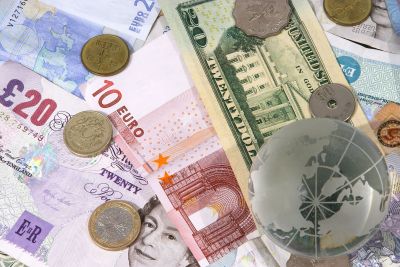Trading currencies or how to deal with currency fluctuations
There is a recent trend that non-professional investors step into the currency trading. The major shifts that the US dollar has made versus the Euro during the last year are probably the reasons for this. Why should you be very, very careful before starting to trade in currencies and what can be the impact of currency fluctuations on investors in stocks and funds.
The exchange rate between currencies is developing 24 hours per day. This exchange rate is the price you need to pay in one currency for another. For example, at the time of writing, one needs to pay 1.37 US dollar for every 1 Euro.

We are talking here exchange rates at the financial markets. When you go to a bank or FOREX (foreign exchange) office you always have to pay more and get less so that they can make some money.
Like for stocks and funds, you can look up the historic development of different exchange rates at Yahoo Finance for example. Here is the US$-Euro exchange rate for example.
Unlike for stock market indices and stocks, it is extremely difficult or maybe impossible to predict the trend in or future if exchange rates. These rates are dependent on so many economic and political factors, so that these movements are very abrupt.
Trends in Currency Exchange Rates
Many financial institutes provide prediction on what they think how major currencies will move the coming year. They do this because they must. Their customers with international business transactions need this kind of predictions to make their financial planning. But that does not make the predictions accurate.
When you look at an historic exchange rate price chart, you can see certain trends. But, note, that is when you look afterwards. The turning points in the exchange rates are very abrupt. The Stock Trend Investing system that is proven in identifying turning points in stock market trends is not capable of predicting these turning points in foreign exchange rates.
Furthermore, when looking at these currency charts, one can see that currency rates can move quite dramatically directly after a turning point. This means for FOREX investors that you need to sit very close on top of it. Daily. For Stock Trend Investors it is advised to review their investments on a monthly basis. For currency traders, this is by far not enough.
Because of the above, I would leave the FOREX or currency trading to the professionals unless you have money to gamble and you think this is more fun than Las Vegas. But remember that even when famous currency trading experts like George Soros take a large currency trading position; it is always described by outsiders as a “bet” again or for that currency.
The Direct Impact
So, what is the direct impact of currency fluctuations on investors in funds and stocks who do not trade in currencies directly? Depending on where you are based and what you consider you home currency compared to in what area you invest, this direct impact can be minimal or quite large.
Let’s take an example. Suppose you are a US investor and count your wealth in US dollars. Suppose you invest in a mutual fund based on European Large Cap and a European index fund. In a situation that the dollar appreciates with 10% (becomes 10% more valuable) compared to the Euro, the European stocks and index would have to increase with more than 10% for you to make any profit. If they increase less than 10%, you make a loss, since you count in dollars.
A similar example can be made for a European investor in US funds or an Australian investor in Japanese funds. The opposite could of course also happen. If your home currency devalues (becomes less worth), the rise of the currency for the funds you have invested in could increase your profits when the markets go up or compensate for (a part of) your losses when the markets go down.
Place a comment when you cannot follow this and I will try to explain it. It is always confusing and when writing this I had to think twice to make sure the examples I give are correct.
Note that the decisive factor for the currency risk is not where the fund is located but where the stocks are based in which the funds is investing. Thus a New York based fund that invests in European equities has a currency risk for its US investors.
What could you do
So, what can Stock Trend Investors do if they want to minimize the direct impact of currency fluctuations?
1) Invest in funds that only cover their home region.
2) Invest in funds that cover a foreign region but that hedge the currency impact.
This hedging means that the fund manager has taken some precautious measures on the FOREX exchange markets that mitigate the impact of possible currency fluctuation. This type of funds is a small minority and you would have to search specifically for it, to find them.
Thus, when exposed with your investments to currency fluctuations, the impact is unpredictable and can be both good and bad. When you invest in overseas regions, be aware of the possible currency impact and decide which percentage of your investments you want to make subject to this.
Spend ten seconds to take our poll and see how people in general respond. What percentage of your investments is outside your own currency zone?
Next & Previous Blog Post
- ‹ previous
- 22 of 174
- next ›


